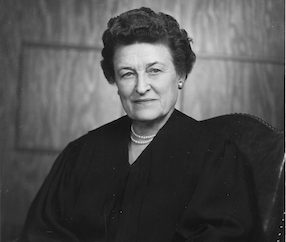
Sarah T. Hughes. (Photo via Archives Department/State Bar of Texas)
March is Women’s History Month. Despite the disheartening news that women and people of color continue to advance incrementally in the profession (and that’s politely putting lipstick on a pig), there have always been women lawyers and judges fighting challenging odds to make a difference. Sandra Day O’Connor, the first woman appointed to the United States Supreme Court, Ruth Bader Ginsburg, and then Sonia Sotomayor, and Elena Kagan, and most recently, Amy Coney Barrett. Four women out of nine presently sitting on the Court. Until 30 years ago there were none. And witness Vice President Kamala Harris, a woman lawyer and a BIPOC.
Do any of my fellow dinosaur lawyers remember the name of the federal district judge in Dallas who swore in Lyndon Johnson as president on November 22, 1963, the day that President Kennedy was assassinated? It was Sarah T. Hughes.

How Legisway Helps In-House Teams Manage All Legal Matters In One Trusted Place
Operate with AI driven insights, legal intake, unified content and modular scalability to transform efficiency and clarity.
I didn’t know anything about her except what I remembered from that November day and time. So, I consulted Wikipedia to learn more about Judge Hughes.
President Kennedy appointed her to the Federal District Court for the Northern District of Texas, and I would guess that the last thing she ever thought she would have to do would be to swear in Johnson after Kennedy’s murder. She was a close friend of the Johnson family and it is said that LBJ wanted her to administer the oath of office to him and even waited for her to make the drive to Love Field in Dallas to do so.
Born in 1898, Hughes graduated from George Washington University Law School along with her husband in 1922. They moved to Dallas after graduation, and no surprise, he was able to find a lawyer job easily, she not so lucky. (Sound familiar?) So, she started out essentially as a solo, using space from a small firm and taking some of their cases in exchange for her services as a receptionist. Hughes became involved in a number of women’s organizations in Dallas and entered politics in 1930 when she was elected to the Texas House of Representatives.
In 1935, she was appointed to the Fourteenth District State Court in Dallas, and repeatedly re-elected until 1961. Judge Hughes was the first woman state district court judge in Texas.

Why Your Practice Is Burning Money And How You Can Do Better
Our expert panel explores common sources of profit leakage along with practical steps for improvement.
Even though women had won the right to vote in 1920, in Texas, women were not allowed to serve as jurors. Judge Hughes could be a judge, but not a juror. She pushed for an amendment to that effect, but it went nowhere. Partially due to her work, Texas law changed in 1954 so that women could indeed serve as jurors.
In 1961, President Kennedy appointed her to the United States District Court for the Northern District of Texas. Originally a recess appointment, Kennedy nominated her again in January 1962, and she was confirmed 60 days later. She was the first female federal district court judge in Texas, and only the third federal district female judge in the country.
Hughes was on a three-judge panel that originally heard Roe v. Wade in the years before it went to the United States Supreme Court. She was also very involved in upgrading conditions at the Dallas County Jail.
Imagine all that she did in times that were far worse for women lawyers than conditions today. She lived through the Depression, both world wars, and many other perilous times. She distinguished herself through her work and her life and wasn’t afraid to make enemies if doing so was in furtherance of her goals.
Closer to my home, how many lawyers east of the Sierra know the name Joyce Kennard? She was an associate justice of the California Supreme Court from 1989 to her retirement in 2014. If there is any woman, any person, who personifies grit, determination, perseverance, and achievements, it is Justice Kennard, a woman of mixed race who overcame tremendous hardships to become an associate justice.
Born in 1941, Kennard grew up in a Quonset hut in Indonesia during World War II. English was the third language she learned, after Dutch and German. During the war, her Dutch father died in a Japanese prison camp. She and her Chinese-Indonesian mother and other family members were sent to a protective camp to wait out the war’s end.
Kennard felt the heaviness of racism as she grew up. Classified as “nonwhite,” the family’s living conditions were poor. One of the justice’s first glimpse of life beyond hers was a Sears catalog that a friend showed her. She is female, an Asian, and a person with a disability (an above the knee amputation for a tumor when she was a teen).
Her disability prevented her from attending college in the Netherlands, where she and her mother eventually moved after the war. After arriving in the States, and undeterred, she worked her way through the University of Southern California and while working as a legal secretary was encouraged to go to law school.
After graduation, the civil division of the California Attorney General’s office wanted to hire her … as a secretary. (Shades of Sandra Day O’Connor.) Kennard landed at the California Attorney General’s office in the criminal division. From there, her trajectory was straight up. She went from a job as an appellate research attorney to the Los Angeles Superior Court to the Court of Appeal and then, in 1989, appointed to the California Supreme Court. Justice Kennard was only the second woman appointed to that court; the first, Rose Bird, who had been both the first woman and first woman Chief Justice on the Court had been ousted several years before in a retention election.
Until Kennard retired in 2014, she was a justice with a very independent streak. She did not go along to get along, and her judicial opinions (often dissents) show that independence. She was one of the four votes needed to strike down Proposition 8.
All women lawyers and judges have herstories. We should recognize and celebrate these two women and their achievements. Phooey on “incremental advancement.”
 Jill Switzer has been an active member of the State Bar of California for over 40 years. She remembers practicing law in a kinder, gentler time. She’s had a diverse legal career, including stints as a deputy district attorney, a solo practice, and several senior in-house gigs. She now mediates full-time, which gives her the opportunity to see dinosaurs, millennials, and those in-between interact — it’s not always civil. You can reach her by email at [email protected].
Jill Switzer has been an active member of the State Bar of California for over 40 years. She remembers practicing law in a kinder, gentler time. She’s had a diverse legal career, including stints as a deputy district attorney, a solo practice, and several senior in-house gigs. She now mediates full-time, which gives her the opportunity to see dinosaurs, millennials, and those in-between interact — it’s not always civil. You can reach her by email at [email protected].